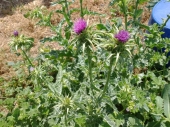I'm making a spreadsheet where I want to be able to automatically calculate the days to harvest; however, often this date is listed as a range of dates and I don't want to get all complicated with a formula that accounts for that range.
So now I'm staring at the wall trying to decide to pick the first date, the last date, or something in the middle??? I know this is a silly quandry, but I'd love to hear how everyone else trys to calculate their harvest date.
Which brings up another topic...that days to maturity aren't the same as days to harvest. And half the time, i can't find both of these pieces of info since I'm growing a lot of herbs.
ANd a third topic, some crops can be harvested over a range of dates so they'd have beginning harvest, and ending harvest, which I suppose I can just plug in as I go along.
I know this isn't an exact science, but I'd like to have a better idea of the timeline until I get it under my belt.
Thanks!




